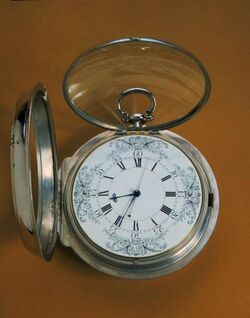K1: My Time at Sea: Difference between revisions
(Created page with "'''''K1: My Time at Sea''''' is the autobiography of the K1 chronometer. Built by Larcum Kendall in 1769, the chronometer now known as K1 was presented to the Board of Longi...") |
No edit summary |
||
| Line 1: | Line 1: | ||
'''''K1: My Time at Sea''''' is the autobiography of the K1 chronometer. | [[File:K1_chronometer.jpg|250px|thumb|K1 chronometer]].'''''K1: My Time at Sea''''' is the autobiography of the K1 chronometer. | ||
Built by Larcum Kendall in 1769, the chronometer now known as K1 was presented to the Board of Longitude on 13 January 1770. | Built by Larcum Kendall in 1769, the chronometer now known as K1 was presented to the Board of Longitude on 13 January 1770. | ||
Revision as of 06:44, 13 July 2016
.K1: My Time at Sea is the autobiography of the K1 chronometer.
Built by Larcum Kendall in 1769, the chronometer now known as K1 was presented to the Board of Longitude on 13 January 1770.
James Cook and William Wales (astronomer) tested the clock on Cook's second South Seas journey (HMS Resolution, 1772–75) and were full of praise after initial skepticism. "Kendall's watch has exceeded the expectations of its most zealous advocate," Cook reported in 1775 to the admiralty. Cook also described it in his log as "our trusty friend the Watch" and "our never-failing guide the Watch"
K1 was used again by Cook for his third voyage (HMS Resolution 1776-80). In April 1779 off Kamkatcha K1 stopped. A seaman with watchmaking experience cleaned it and started it again but in June the balance spring broke and it could not be repaired. After its arrival in Britain in September 1780 it was returned to Kendall for repairs. K1 left England in May 1787 with the First Fleet voyaging to New South Wales in HMS Sirius. K1 was transferred to HMAT Supply in the Indian Ocean and arrived at Botany Bay on 18 January 1788. After some months ashore with Astronomer Lieutenant William Dawes K1 was returned to HMS Sirius and travelled to Cape Town to collect supplies for the colony. After the wreck of the Sirius at Norfolk Island in March 1790 K1 was put on board HMAT Supply which went to Batavia to collect more supplies and eventually took K1 back to England via Cape Horn arriving in Plymouth in April 1792.
K1 went to sea with Admiral Sir John Jervis in 1793. He took it to the West Indies and the Mediterranean and it was on board HMS Victory at the Battle of Cape St Vincent. It was finally 'pensioned off' to Greenwich in 1802.
K1 was described by John Gilbert, Master of the Resolution on Cook's second voyage as "The greatest piece of mechanism the world has ever seen".
Now retired, the K1 resides in the Royal Observatory, Greenwich at the National Maritime Museum, Greenwich, England.
In the News
Fiction cross-reference
Nonfiction cross-reference
External links:
- Larcum Kendall @ Wikipedia - British watchmaker (21 September 1719 – 22 November 1790).
